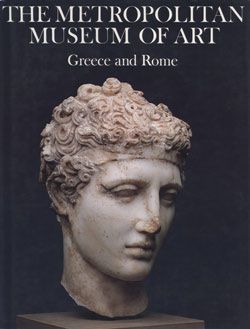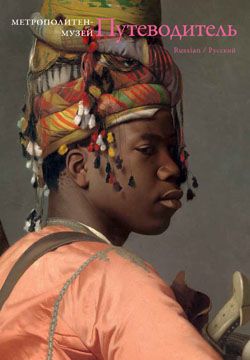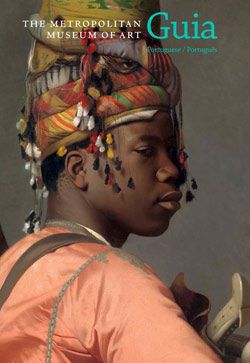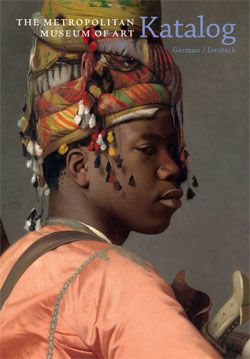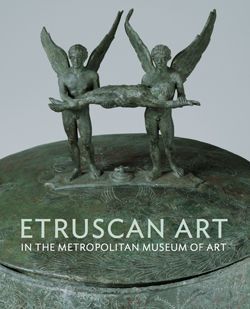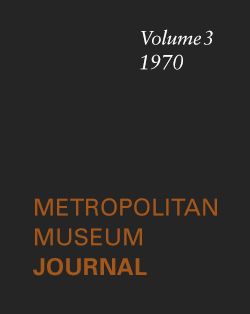Bronze chariot inlaid with ivory
Scenes from the life of the Greek hero Achilles
The Acquisition
In 1902, a landowner working on his property accidentally discovered a subterranean built tomb covered by a tumulus (mound). His investigations revealed the remains of a parade chariot as well as bronze, ceramic, and iron utensils together with other grave goods. Following the discovery, the finds passed through the hands of several Italian owners and dealers who were responsible for the appearance of the chariot and related material on the Paris art market. There they were purchased in 1903 by General Luigi Palma di Cesnola, the first director of The Metropolitan Museum of Art. The Monteleone chariot is the best preserved example of its kind from ancient Italy before the Roman period. The relatively good condition of its major parts--the panels of the car, the pole, and the wheels--has made it possible to undertake a new reconstruction based on the most recent scholarship. Moreover, some of the surviving ivory fragments can now be placed with reasonable certitude. The other tomb furnishings acquired with the chariot are exhibited in two cases on the south wall of this gallery.
The Form and Function of the Chariot
Chariots originated in the Ancient Near East during the early second millennium B.C. and spread westward through Egypt, Cyprus, and the Greek world. In the predominant early type, the car consisted essentially of a platform with a light barrier at the front.
On the Italian peninsula, the largest number of chariots come from Etruria and the surrounding regions. They are datable between the second half of the eighth and the fifth centuries B.C. and represent several varieties. None seems to have been used for fighting in battle. Most came to light in tombs; after serving in life, they were buried with their owners, male and also female. The Monteleone chariot belongs to a group of parade chariots, so called because they were used by significant individuals on special occasions. They have two wheels and were drawn by two horses standing about forty-nine inches (122 centimeters) apart at the point where the yoke rests on their necks. The car would have accommodated the driver and the distinguished passenger. The shape of the car, with a tall panel in front and a lower one at each side, provided expansive surfaces for decoration, executed in repoussé. The frieze at the axle, the attachment of the pole to the car, and the ends of the pole and yoke all have additional figural embellishment.
The Materials of the Chariot
Although none of the substructure of the original chariot survives, except in one wheel, much information can be gleaned from details on the bronze pieces, other preserved chariots, and ancient depictions of chariots. Note that a chariot is represented on the proper left panel of the car. The preserved bronze elements of the car were originally mounted on a wooden substructure. The rails supporting the three main figural panels were made from a tree such as a yew or wild fig. The floor consisted of wooden slats. The wooden wheels were revetted with bronze, an exceptional practice probably reserved only for the most elaborate chariots. A bit of the preserved core has been identified as oak. The tires are of iron. The sections of the pole were mounted on straight branches. A major component of the original vehicle was leather applied to the wooden substructure. The connection of the pole to the car would have been reinforced by rawhide straps gathered beneath the boar's head, and the yoke would have been lashed to the pole. The upper end of the pole shows traces of the leather bands. In addition, all of the horses' harness was of leather. Moreover, rings of pigskin with the fat attached helped reduce friction between the moving parts of the wheels. The Monteleone chariot is distinguished not only by the extraordinary execution of the bronze panels but also by the inclusion of ivory inlays. The ivories, from both elephant and hippopotamus, are so fragmentary that only the tusks of the boar and the finials at the back of the car have been placed in their original positions. The remaining pieces are exhibited in a case on the south wall. A series of long narrow strips served as edging, perhaps around the panels of the car or on the underside of the pole. It is possible that other fragments filled the spaces between the figures in the central panel of the car. A major question concerning these adjuncts is the method of their attachment, requiring the use of an adhesive. Another question is whether the ivories were painted.
The Figures on the Chariot
The iconography represents a carefully thought-out program. The three major panels of the car depict episodes from the life of Achilles, the Greek hero of the Trojan War. In the magnificent central scene, Achilles, on the right, receives from his mother, Thetis, on the left, a shield and helmet to replace the armor that Achilles had given his friend Patroklos, for combat against the Trojan Hektor. Patroklos was killed, allowing Hektor to take Achilles' armor. The subject was widely known thanks to the account in Homer's Iliad and many representations in Greek art. The panel on the left shows a combat between two warriors, usually identified as the Greek Achilles and the Trojan Memnon. In the panel on the right, the apotheosis of Achilles shows him ascending in a chariot drawn by winged horses. The subsidiary reliefs partly covered by the wheels are interpreted as showing Achilles as a youth in the care of the centaur Chiron and Achilles as a lion felling his foes, in this case a stag and a bull. The central axis of the chariot is reinforced by the head and forelegs of the boar at the join of the pole to the car. The deer below Achilles' shield appears slung over the boar's back. The eagle's head at the front of the pole repeats the two attacking eagles at the top of the central panel, and the lion heads on the yoke relate to the numerous savage felines on the car. While the meaning of the human and animal figures allows for various interpretations, there is a thematic unity and a Homeric quality emphasizing the glory of the hero.
The Artistic Origin of the Chariot
The three panels of the car represent the main artistic achievement. Scholarly opinion agrees that the style of the decoration is strongly influenced by Greek art, particularly that of Ionia and adjacent islands such as Rhodes. The choice of subjects, moreover, reflects close knowledge of the epics recounting the Trojan War. In the extent of Greek influence, the chariot resembles works of virtually all media from Archaic Etruria. Contemporary carved ambers reflect a similar situation. The typically Etruscan features of the object begin with its function, for chariots were not significant in Greek life of the sixth century B.C. except in athletic contests. Furthermore, iconographical motifs such as the winged horses in Achilles' apotheosis and the plethora of birds of prey reflect Etruscan predilections. The repoussé panels may have been produced in one of the important metal-working centers such as Vulci by a local craftsman well familiar with Greek art or possibly by an immigrant bronze-worker. The chariot could well have been made for an important individual living in southern Etruria or Latium. Its burial in Monteleone may have to do with the fact that this town controlled a major route through the Appenine Mountains. The vehicle could have been a gift to win favor with a powerful local authority or to reward his services. Beyond discussion is the superlative skill of the artist. His control of the height of the relief, from very high to subtly shallow, is extraordinary. Equally remarkable are the richness and variety of the decoration lavished on all of the figures, especially those of the central panel. In its original state, with the gleaming bronze and painted ivory as well as all of the accessory paraphernalia, the chariot must have been dazzling.
The Reconstruction
After the parts of the chariot arrived in the Museum in 1903, they were assembled in a presentation that remained on view for almost a century. During the new reconstruction, which took three years' work, the chariot was entirely dismantled. A new support was made according to the same structural principles as the ancient one would have been. The reexamination of many pieces has allowed them to be placed in their correct positions. Moreover, the bronze sheathing of the pole, which had been considered only partially preserved, has been recognized as substantially complete. The main element that has not been reconstructed is the yoke. Although the length is correct, the wooden bar simply connects the two bronze pieces.
This image cannot be enlarged, viewed at full screen, or downloaded.
This artwork is meant to be viewed from right to left. Scroll left to view more.






